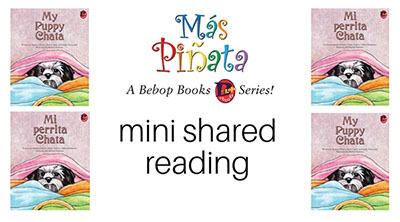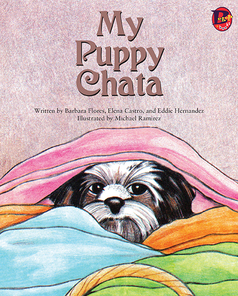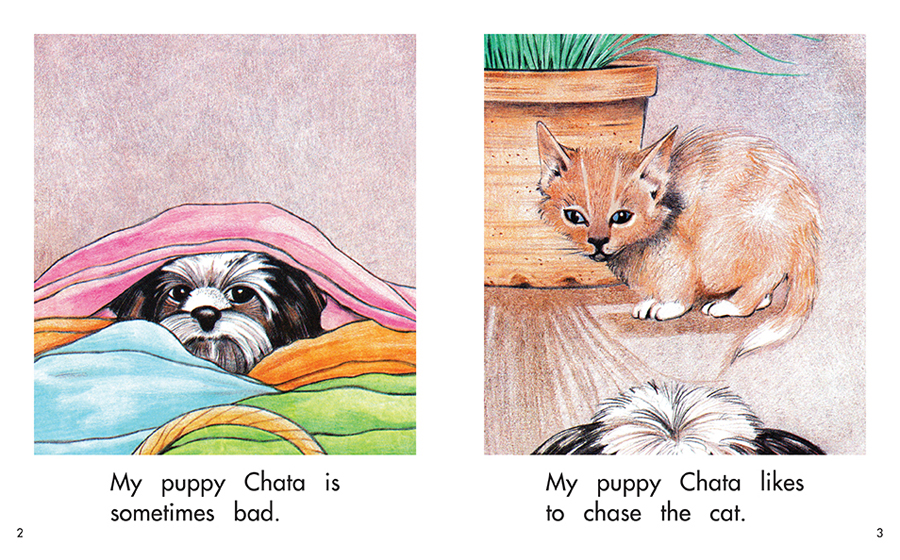 In the second post of our new Más Piñata blog series, Dr. Barbara Flores introduces the benefits of Mini Shared Reading, a method that prepares children to become independent readers.
In the second post of our new Más Piñata blog series, Dr. Barbara Flores introduces the benefits of Mini Shared Reading, a method that prepares children to become independent readers.
Knowing How Children Learn and What Proficient Readers Do Is Important for Family Literacy
Parents and guardians are the first teachers of all children. We believe that all learning is sociocultural and pivotal in the lives of our children.
Based on Vygotsky’s (1978) sociocultural theory of learning, teaching and development and Goodman’s Sociopsycholinguistic theory of proficient reading (1994), I developed Mini Shared Reading. Mini Shared Reading acts as a bridge between Reading Aloud and Guided Reading that teaches and prepares children’s towards learning to become Independent Proficient Readers.
Mini Shared Reading is a way of teaching and reading that accommodates the children/child at their developmental level. Mini Shared Reading helps the adult engage with the child in reading a book collaboratively while utilizing their “zone of proximal development.”
Más Piñata books build in prediction with the illustrations because of the patterned language/text used on each page of a story. Sometimes the object/noun changes or the verb/action is different, but the rest of the pattern remains the same. One of our beloved Más Piñata titles, My Puppy Chata, is a predictable book about a mischievous puppy. Every child loves to read about puppies, so we created a story line about a playful puppy named Chata.
 The sentences on each page begin with, “My puppy Chata,” to ensure predictability and to provide context to the reader that Chata is doing something “bad” or “playful.” Because each illustration matches the text, children will be better equipped to read this 8-page book after engaging in the Mini Shared Reading routine.
The sentences on each page begin with, “My puppy Chata,” to ensure predictability and to provide context to the reader that Chata is doing something “bad” or “playful.” Because each illustration matches the text, children will be better equipped to read this 8-page book after engaging in the Mini Shared Reading routine.
Mini Shared Reading Routine
When selecting a predictable book, it’s important to choose one that appeals to the child’s interests. Once you find a time and a special place to sit down together, perhaps with the child sitting next to you, then you both can look at the book.
Mini Shared Reading at school follows a similar routine but it involves small group instruction with 3-5 students in a 20 to 30-minute reading block.
Picture Walk and Talk
Start by saying to the child: “We are going to do a picture walk and talk to get familiar with the story.” As you look at each illustration, you and the child talk about what you see. For example, on the page that shows, “My puppy Chata likes to chase the cat,” you can say: “What do you think Chata is doing? Why is the cat on top of the table?” As you talk, you are building on the child’s prior experience and knowledge of dogs chasing cats. The language that you are using is preparing the child for when you actually read the book.
Next, you say that you are going to read the book three times. The first time, you are going to read it the way it’s supposed to be read. The second time, you will read each page and then the child will echo read. The third time, the child will read the book by himself/herself with your guidance whenever needed.
Revisiting the Text/Illustrations and Talking About Them
Now, you are ready to make visible the connections between the illustration and the text on each page. You start from the back of the book because you want to disrupt any potential memorization of the text. You’re also building on children’s growing knowledge of what a sentence and words look like and how letters and sounds make up those respective words.
Making the Reading Strategies Visible
An example of making children aware of what they’re reading is asking the child if the illustrations match the sentence and text in the book. By asking this question, the child is confirming that the illustration does in fact match the text. Next, you ask the child to find a word in the sentence. If the child does not know what a word is, you can point out where the word is and say, for example, “Here is the word, ‘clothes.’” You have just used language to name the concept of a word and then showed where the word, “clothes,” is in the sentence.
By using this language in the social interaction of this context, you are deliberately teaching the child about the types of written language used to represent meaning. Ultimately, the child has engaged in the act of proficient reading using all the cueing systems, strategies of predicting, confirming and self-correcting plus prior knowledge to make sense of written language.
Closing the Reading Session
You can continue this pattern of social interaction for a couple of more pages so that the child begins to see a pattern. Our brains seek patterns and can make more sense from understanding patterns. Then, finally you ask the child to read the book to you!
Browse our Más Piñata Collections online:
- Más Piñata Dual Language English & Spanish Collection
- Más Piñata English Collection
- Más Piñata Spanish Collection
 Dr. Barbara Flores is a pioneer Latina scholar, activist, and author of the groundbreaking Más Piñata leveled reading series. She is an expert in the areas of biliteracy development, bilingual education, and critical pedagogy. Dr. Flores currently serves as President of the California Latino School Boards Association and is Professor Emeritus at California State University, San Bernardino.
Dr. Barbara Flores is a pioneer Latina scholar, activist, and author of the groundbreaking Más Piñata leveled reading series. She is an expert in the areas of biliteracy development, bilingual education, and critical pedagogy. Dr. Flores currently serves as President of the California Latino School Boards Association and is Professor Emeritus at California State University, San Bernardino.


